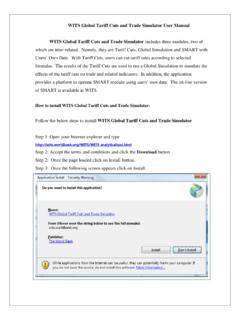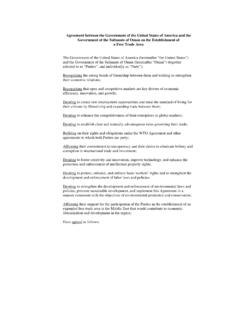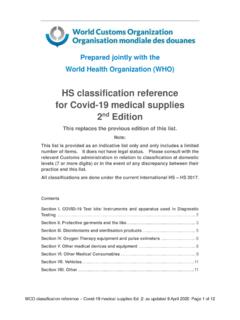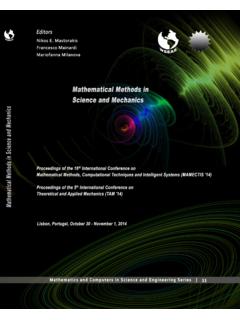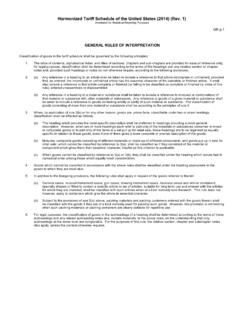Transcription of THE UNCTAD TRADE POLICY SIMULATION MODEL …
1 UNITED NATIONS CONFERENCE ON TRADE AND DEVELOPMENT THE UNCTAD TRADE POLICY SIMULATION MODEL A note on the methodology, data and uses Sam Laird and Alexander Yeats No. 19 The opinions expressed in this paper do not necessarily reflect those of the UNCTAD secretariat. Comments on this paper are invited and should be addressed to the author, c/o the Chairman, UNCTAD Editorial Advisory Board, Palais des Nations, 1211 Geneva 10, Switzerland. Additional copies of this paper may be obtained on request.
2 THE UNCTAD TRADE POLICY SIMULATION MODEL A note on the methodology, data and uses Sam Laird and Alexander Yeats Geneva October 1986 CONTENTS Section Page PREFACE INTRODUCTION 1 I. THE BASIC DATA AND PARAMETERS 4 A. Tariffs 4 B. Non-tariff barriers 5 C.
3 Imports 9 D. Market penetration data 10 E. Elasticities 11 F. Concordances 13 II. USES OF THE MODEL 14 III. FUTURE WORK ON THE MODEL 16 IV.
4 CO-OPERATION WITH OTHER ORGANIZATIONS 18 ANNEX I: TECHNICAL DESCRIPTION OF THE UNCTAD TRADE POLICY SIMULATION MODEL 20 ANNEX II: PRIMARY SOURCES FOR ESTIMATES OF THE TARIFF EQUIVALENTS OF NON-TARIFF BARRIERS 26 ANNEX III: ILUSTRATIONS OF SIMULATIONS MADE WITH THE UNCTAD MODEL 27 Table A1.
5 Grains to developing countries of TRADE liberalization through reduction to zero of tariffs in 20 DMECs, and (b) reduction to zero of tariffs and certain non-tariff barriers (NTBs) in EEC, Japan and the United States; 29 Table A2: Increases in imports by EEC from preference-receiving countries through MFN liberalization of tariffs and non-tariffs barriers; 30 Table A3: Actual values and projected changes in exports and TRADE balances for selected developing countries due to the adoption of a GSTP; 31 Table A4: Projected changes in the structure of developing countries intra- TRADE in primary and processed commodities under preferential tariffs.
6 32 Table A5: Analysis of the influence of a debt-related TRADE liberalization on the export of all and selected developing countries. 33 THE UNCTAD TRADE POLICY SIMULATION MODEL A note on the methodology, data and uses Sam Laird and Alexander Yeats1 PREFACE This note has been prepared in response to numerous requests from individual member States of UNCTAD , from other international organizations and from academic institutions for detailed information on t he methodology and the data used in the UNCTAD TRADE POLICY SIMULATION MODEL (TPSM).
7 The MODEL has been used principally in connection with UNCTAD 's work on protectionism and structural adjustment as well as in evaluating various proposals for a Global System of TRADE Preferences (GSTP) among developing countries. The results have been published mainly in the TRADE and Development Report, various documents for UNCTAD 's TRADE and Development Board and technical working notes on the GSTP. For technical reasons, it was not possible to give a full description of the MODEL and data sources in such documents which are of a POLICY nature and restricted in size.
8 The MODEL has also been used to provide information on the direct TRADE effects of various possible TRADE liberalization scenarios to member States of UNCTAD and other international or-ganizations, notably UNIDO and the World Bank. In this connection, it is felt that the MODEL will be of major practical importance in helping developing countries to assess quantitatively the implications of proposals for TRADE liberalization in any future multilateral TRADE negotiations (MTN), or to assist in evaluating the likely effects of changes in developed countries' generalized system of preference (GSP) schemes.
9 In addition, the UNCTAD secretariat has employed the MODEL in quantifying the potential for alleviating developing country debt burdens through TRADE liberalization initiatives. The work on the MODEL is ongoing, both with respect to the updating of the data and to the MODEL itself. The present note, therefore, is representative only of the current situation (April 1986). Future readers are invited to consult the authors concerning revisions. Comments on data and methodology are welcomed, particularly suggestions for improvement.
10 The authors would also appreciate hearing from researchers who are conducting studies into the restrictiveness of non-tariff barriers. 1 The authors are Economic Affairs Officers, in UNCTAD , Geneva. The views expressed in this paper are those of the authors and do not necessarily reflect the views of the United Nations, or its staff. 1 INTRODUCTION 1. The MODEL used by UNCTAD to estimate various effects of commercial POLICY changes, in-cluding changes in tariff rates and the incidence of non-tariff distortion of international TRADE , may be described technically as an ex ante partial equilibrium MODEL , measuring the first-round effects of the simulated POLICY changes.

